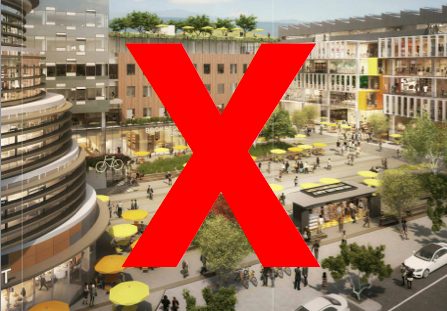We sat down to talk to Ethan Elkind, author of Railtown: The Fight for the Los Angeles Metro Rail and the Future of the City, about California’s housing crisis, the need for growth around L.A. County’s transit system, and how Santa Monica, his former hometown, fits into the larger picture.
Elkind is also an attorney who researches and writes on environmental law for the Center for Law, Energy and the Environment (CLEE) at the UC Berkeley School of Law. He also has an appointment at the UCLA School of Law Environmental Law Center and Emmett Center on Climate Change and the Environment. Below is part one of a two-part conversation. You can read more of his writings about land use, transportation, and music on his personal blog.
Santa Monica Next: There has been a lot of talk about land use problems in California, especially around housing affordability. Can you sum up what is the crux of these problems?
The status quo doesn’t provide enough housing for people, it creates a lot of economic inequality and environmental degradation. Those trends are just getting worse.
Ethan Elkind: The big problem is that California has not been producing enough housing, both for the people who live and for those who are expected to arrive in the next few decades. When I say “arrive,” some of that’s immigration, but some of that’s just natural population growth. If you look at what cities and counties — because they are the ones that are ultimately responsible for land use decisions — what they have been allowing to be built, particularly in our coastal metropolitan areas, going back to the 1970s, it’s been really restricted.
Meanwhile, this is a very desirable place to live, the economy has been booming, in coastal California at least. Without the housing production in place, housing prices, rental prices have skyrocketed. What we’ve seen in the state as a result is huge inequality. We’ve seen people spend huge percentages of their budgets not just for housing but also transportation because where middle-class, working class people have to live to afford a safe, decent neighborhood with good schools, they now have to move into that eastern part of California.
If you’re in the bay area, that means moving out to places like Stockton for example. If you are in Los Angeles, that means moving out to the Inland Empire, Lancaster, Palmdale area, Victorville, even. That’s where people can afford to live. But then, they have to spend a huge percentage of their budget on transportation. So, you get the worst of all worlds economically and environmentally because it’s driving up air pollution emissions, it’s destroying a lot of our prime farmland, a lot of our open space, and it’s creating misery and difficulty for a lot of people.
This is really avoidable, but the problem is that cities and counties, once the initial wave of residents move in, they don’t allow any new housing to be built. They’ve artificially restricted and overregulated the market.
In Santa Monica, there’s been a lot of good development in the city. I lived there for almost 10 years; I moved away in 2008, but I come back frequently. I was particularly saddened to see the uproar over the Papermate site and now this recent effort to downzone the major transit corridors. This is a good example of what’s been happening in cities and counties throughout coastal California.
SMN: You talked about the proposed downzoning in Santa Monica. In some ways, Santa Monica has been a bit ahead of the curve. They’ve allowed for some growth. While it has arguably not been enough, it is more than many other coastal communities are allowing. Why are we going back on progressive policies?
The region is now spending tens of billions of dollars on rail expansion and if the locals don’t allow development around those transit stations, it’s essentially a waste of money.
EE: There is a historical arc here. When you look back to the 70s, Santa Monica shot down a bunch of big projects that were proposed. There’s an interesting history there around celebrities like Tom Hayden, Jane Fonda, organizing to kill development projects. Bill Fulton details it in his book, The Reluctant Metropolis.
I think things kind of went dormant. Then, traffic got so bad in the Westside right after I moved there, actually, because all the former industrial area south of Wilshire, south of Santa Monica Boulevard, the city made the decision to change that over into offices and so Santa Monica has become this big office destination now, so you see a pretty remarkable reverse of the historic traffic commute. There’s this plethora of jobs in Santa Monica, but not enough housing.
Even in the time I was there, from 1999 to 2008, it was amazing how much worse the traffic got. You really felt trapped in the city. That spawned two reactions. On the one hand, people became much more in favor of transit. The other reaction, from some of the more progressive leaders, is to try to build along some of these corridors and build in downtown [Santa Monica].
You now start to see the backlash to plans that had been put in place a few years before. So, you see, essentially, a lot wealthy homeowner groups, to my understanding funded by some businesses for competitive reasons, organizing and hiring attorneys to shoot down a badly needed development project with a lot of new housing and great transportation improvements for the city, to shoot that down through the threat of voter initiative, I think that was really a key turning point, not just for Santa Monica, but for all of Los Angeles.
If you are not going to build in a place like Santa Monica, where are the people who would have lived there going to live now? They are going to be pushed farther and farther out into the peripheral edge areas of the urban landscape and that’s going to have environmental consequences.
The region is now spending tens of billions of dollars on rail expansion and if the locals don’t allow development around those transit stations, it’s essentially a waste of money. It’s a waste of the entire county’s investment if we don’t allow the development to happen because, then, you aren’t going to get the ridership numbers that you need. You aren’t going to see the development patterns that mean people will have more jobs, homes, and services in that immediate area to take advantage of the [rail] line.
It’s a real tragedy, certainly for L.A. County and it sends a chilling signal across California to developers who might want to take advantage of these rail transit areas and build neighborhoods and communities that really work with the transit system.
If they aren’t allowed to do it because of a citizen revolt of all the homeowners who are already established in the neighborhood who don’t want any new residents, then we’ve got a real problem because what that does is reinforce the status quo. The status quo doesn’t provide enough housing for people, it creates a lot of economic inequality and environmental degradation. Those trends are just getting worse.
SMN: You said the revolt against better land use policies seems to come out of frustration with growing traffic, yet by stopping smart growth near transit, it is actually making traffic worse.
EE: Yeah. No one is happy with the status quo. There’s no easy solution here. The real key is to give people options to live in neighborhoods where they can opt out of the traffic. When I lived in Santa Monica, I worked… for an entertainment company at Cloverfield and Colorado and I had the opportunity, living in Santa Monica, to ride my bike to work every day and I completely opted out of the traffic.
The only time I had to deal with the traffic was when I wanted to go downtown or to the Hollywood Bowl or a Dodgers game. The rest of the time, I could opt out. I had that option. I was able to find a relatively affordable place in Santa Monica to give me access to that.
We should be providing those options to people.
I think the Hines project would have been an example of that. It was 40 percent residential and that would have given all those people an opportunity to walk or bike to all the jobs that are available in the corridor.
SMN: If cities with progressive reputations like Santa Monica and San Francisco are fighting progressive land use changes, what does that mean for the rest of coastal California?
I think when it comes to land use, we have to throw out this notion of progressive versus conservative because the “progressive” attitude in Santa Monica, Berkeley has been very hostile to new real estate projects and very much about the status quo. Historically, they have held “no growth” type attitudes.
Likewise, the conservatives. You’ll see a lot of conservative, affluent communities that are also against new development.
Meanwhile, progressives, who you’d think would care a lot about environmental causes, care a lot about equality, equity, access to affordable housing, they do, but at least in these affluent communities [like Santa Monica and Berkeley], they don’t want it to happen in their own community.
I think people who care about these issues need to get the word out and motivate people so we don’t just hear from the angriest, loudest people in the community and the vast middle has an opportunity to weigh in and understand what the stakes are.
If you are not going to build in a place like Santa Monica, where are the people who would have lived there going to live now? They are going to be pushed farther and farther out into the peripheral edge areas of the urban landscape and that’s going to have environmental consequences.
SMN: If the people who ostensibly care about these issues — sustainability, equity — are resistant to what we need to do to solve those problems on the local level, what can be done?
EE: It’s a great question. In terms of what can be done, it is very challenging because there is ultimately that local control over land use decision making and there is no way around that. Politically, I don’t see that really changing, except maybe around the edges.
Ultimately, it’s going to be a city-by-city, county-by-county battle. It’s easy to say, “Santa Monicans feel this way,” but we are not talking about a huge percentage of people. I think most people aren’t that engaged in land use issues. So, the really strident voices you hear are those that are directly affected and therefore most motivated to show up.
I think there is a political opportunity to try to mobilize that vast center and explain to them how they will benefit from these kinds of projects.
The other piece of it is demographic change is making a difference. If you look at the polling around the Millennial generation, for example, they are not interested in spending their lives stuck in traffic and living in a cul-de-sac somewhere.
A lot of them grew up in these safe, nice, but ultimately very boring suburban communities. They aren’t afraid of the diversity and excitement of urban environments like the previous generation seems to have been. As Millennials assume leadership position, I think that will make a difference in terms of land use policies.
I think people who care about these issues need to get the word out and motivate people so we don’t just hear from the angriest, loudest people in the community and the vast middle has an opportunity to weigh in and understand what the stakes are.


